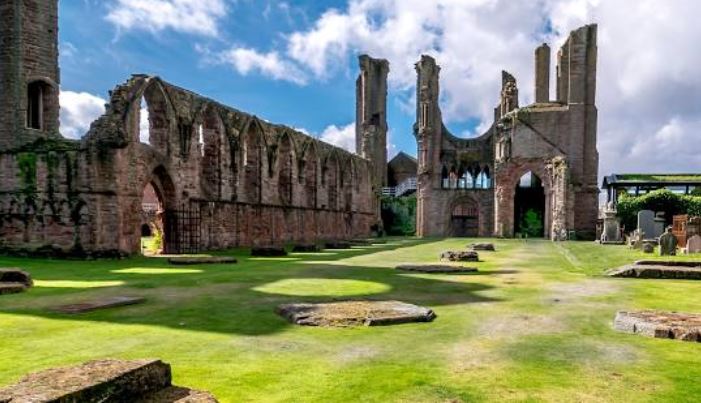Brief Overview of Arbroath Abbey
Arbroath Abbey, located in Arbroath, Scotland, is a historic site renowned for its rich heritage and architectural splendor. Founded in 1178 by King William the Lion, this Cistercian monastery was one of Scotland’s most influential religious centers during the medieval period. The abbey is particularly famous for its role in the creation of the Declaration of Arbroath, a key document in Scottish history. Today, the abbey’s impressive Gothic ruins attract visitors from around the world, drawn by its historical significance and architectural beauty.
Historical and Cultural Significance
The Declaration of Arbroath (1320)
Background and Context of the Declaration of Arbroath
The Declaration of Arbroath, signed in 1320, is one of Scotland’s most significant historical documents. Drafted during the Wars of Scottish Independence, the declaration was a formal appeal to Pope John XXII, asserting Scotland’s right to self-governance and independence from English rule. The document emerged during a time of intense conflict between Scotland and England, as the Scottish nobility sought to assert their nation’s sovereignty and legitimacy.
Importance of the Document in Scottish History
The Declaration of Arbroath is celebrated as a powerful assertion of Scottish identity and independence. It is often compared to the American Declaration of Independence for its emphasis on national self-determination and the right of a people to govern themselves. The document articulates a clear vision of Scotland’s independence, challenging the English crown’s claim to Scottish territory. Its enduring legacy is reflected in its role as a symbol of Scottish nationalism and resistance against foreign domination.
The Role of the Abbey in the Declaration’s Creation and Its Impact on Scottish Nationalism
Arbroath Abbey was central to the creation of the Declaration of Arbroath. The abbey’s role as a prominent religious and cultural institution provided a fitting backdrop for the drafting and signing of this important document. The abbey’s association with the declaration helped cement its place in Scottish history as a site of national significance. The declaration’s impact on Scottish nationalism is profound; it has inspired generations in their pursuit of freedom and has become a cornerstone of Scottish cultural heritage.

Architectural Features
Gothic Architecture
Arbroath Abbey is renowned for its stunning Gothic architectural style, a hallmark of medieval ecclesiastical design. The abbey’s architecture reflects the grandeur and complexity of Gothic art, characterized by its intricate and soaring elements. One of the most striking features is the rose window, an ornate circular window with elaborate stained glass that captures the light and adds a vibrant splash of color to the abbey’s facade. The tracery of the window, with its delicate stone patterns, enhances the intricate design, creating a visual symphony of shapes and forms.
Key architectural elements of the abbey include the pointed arches, which are a defining characteristic of Gothic architecture. These arches are not only aesthetically pleasing but also structurally significant, as they distribute the weight of the building more effectively. The ribbed vaults, which intersect to form a series of ribs across the ceiling, further illustrate the sophistication of Gothic construction. These features allowed for the creation of high, expansive interiors that were both awe-inspiring and functional.
The design of Arbroath Abbey exemplifies medieval ecclesiastical architecture by combining these elements to create a space that is both grand and spiritually uplifting. The abbey’s layout and decoration reflect the Gothic period’s emphasis on verticality and light, aiming to inspire reverence and awe in those who entered its doors.
Monumental Ruins
Despite the ravages of time and conflict, Arbroath Abbey’s ruins remain remarkably well-preserved, offering a glimpse into its former splendor. The scale of the abbey is still impressive, with substantial portions of the church and surrounding buildings intact. The remains include portions of the nave, choir, and chapter house, allowing visitors to appreciate the abbey’s original grandeur.
The preservation of these ruins provides valuable insights into medieval construction techniques. The use of high-quality sandstone and sophisticated building methods is evident in the remains, highlighting the skill of the medieval builders. The construction techniques, such as the use of flying buttresses to support the structure’s weight, are still discernible in the surviving stonework, showcasing the advanced engineering knowledge of the time.
Influence on Scottish Architecture
Arbroath Abbey’s architectural design had a lasting impact on other ecclesiastical buildings in Scotland. Its Gothic elements, particularly the pointed arches and ribbed vaults, influenced the design of subsequent churches and abbeys. The abbey’s layout and ornamental details became a model for other religious structures, reflecting the broader trends of Gothic architecture in Scotland.
The abbey’s architectural legacy is evident in the way its design principles were adopted and adapted by later builders. The influence of Arbroath Abbey can be seen in the construction of other significant Gothic buildings across Scotland, reinforcing its role as a key exemplar of medieval Scottish architecture. The abbey’s design set a standard for beauty and structural innovation that continued to inspire architects and builders long after its construction.

Tourist Attraction and Preservation
Visitor Experience
Today, Arbroath Abbey is a prominent tourist destination managed by Historic Scotland. Visitors flock to the site to explore the awe-inspiring ruins and delve into Scotland’s rich history. The abbey offers a range of experiences, including guided tours that provide insights into the abbey’s historical and architectural significance. These tours are designed to enhance visitors’ understanding of the abbey’s role in Scottish history, particularly its association with the Declaration of Arbroath.
In addition to tours, Arbroath Abbey hosts various exhibitions and educational programs. These initiatives include interactive displays and informative panels that cover different aspects of the abbey’s past, from its founding to its architectural features. Special events and educational activities are often organized to engage visitors of all ages, making the site both informative and accessible.
The abbey’s role in modern Scottish tourism is significant, drawing tourists who are interested in Scotland’s medieval history and architectural heritage. It serves as a key cultural landmark, helping to promote Scotland’s historical narrative and attracting history enthusiasts from around the globe.
Preservation Efforts
The preservation of Arbroath Abbey is a priority for Historic Scotland, which is responsible for maintaining and protecting this historic site. Ongoing preservation work involves stabilizing the ruins to prevent further deterioration and ensuring the site’s structural integrity. This includes regular inspections and conservation measures to address any issues caused by weathering or other environmental factors.
Efforts to protect and stabilize the site are critical for preserving its historical and architectural value. Measures such as repairing damaged stonework and reinforcing vulnerable areas help to safeguard the abbey for future generations. The preservation work aims to balance the need for conservation with the desire to keep the site accessible and informative for visitors.
Educational initiatives are also a key aspect of preservation. Historic Scotland provides resources and programs designed to educate the public about the abbey’s history and significance. These resources include detailed informational materials, educational workshops, and interactive exhibits, all of which help to deepen visitors’ understanding of the abbey’s cultural heritage.
Arbroath Abbey stands as a testament to Scotland’s rich historical and architectural heritage. Its significance is highlighted by its association with the Declaration of Arbroath, a landmark document in the nation’s quest for independence. Architecturally, the abbey exemplifies the grandeur of Gothic design, with its intricate features and monumental ruins reflecting the skill and artistry of medieval builders.
The abbey’s importance extends into modern times through its role as a major tourist attraction and the ongoing preservation efforts that protect its legacy. As a symbol of Scottish history and culture, Arbroath Abbey continues to captivate visitors and inspire admiration for its historical, cultural, and architectural achievements. Its place in Scottish heritage remains secure, ensuring that its story will continue to be told for generations to come.
FAQ
1. What is Arbroath Abbey most famous for?
Arbroath Abbey is best known for being the site where the Declaration of Arbroath was drafted in 1320. This significant historical document asserted Scotland’s right to self-governance and played a crucial role in the country’s fight for independence from England. The abbey is also celebrated for its impressive Gothic architecture and historical influence.
2. When was Arbroath Abbey founded, and by whom?
Arbroath Abbey was founded in 1178 by King William the Lion of Scotland. It was established as a Cistercian monastery and became a prominent religious and cultural center during the medieval period.
3. What architectural style is Arbroath Abbey known for?
Arbroath Abbey is renowned for its Gothic architectural style. Key features include its pointed arches, ribbed vaults, and a stunning rose window. The abbey’s design exemplifies the grandeur and complexity of medieval ecclesiastical architecture.
4. What are some notable architectural elements of Arbroath Abbey?
Notable architectural elements of Arbroath Abbey include its intricately designed rose window, elaborate tracery, pointed arches, and ribbed vaults. These features highlight the sophistication and beauty of Gothic architecture.
5. How is Arbroath Abbey preserved and maintained?
The preservation of Arbroath Abbey is managed by Historic Scotland, which undertakes ongoing maintenance work to stabilize and protect the ruins. This includes repairing damaged stonework, reinforcing vulnerable areas, and addressing environmental impacts. Educational initiatives and resources are also provided to inform visitors about the abbey’s history.
6. What can visitors expect when they visit Arbroath Abbey?
Visitors to Arbroath Abbey can explore the extensive ruins, including the remains of the church and surrounding buildings. Guided tours, exhibitions, and educational programs offer insights into the abbey’s historical and architectural significance. The site also hosts special events and activities to enhance the visitor experience.
7. How does Arbroath Abbey influence Scottish architecture?
Arbroath Abbey’s design has had a lasting impact on other ecclesiastical buildings in Scotland. Its Gothic elements, such as the pointed arches and ribbed vaults, influenced the design of subsequent churches and abbeys, reinforcing its legacy in Scottish architectural history.
8. Why is the Declaration of Arbroath significant in Scottish history?
The Declaration of Arbroath is significant because it represents a formal assertion of Scotland’s right to independence from England. The document, addressed to Pope John XXII, was a crucial part of Scotland’s struggle for sovereignty and remains a symbol of Scottish nationalism and self-determination.
9. What efforts are made to educate the public about Arbroath Abbey?
Historic Scotland provides various educational resources and programs to inform the public about Arbroath Abbey. This includes informative displays, interactive exhibits, and workshops designed to enhance visitors’ understanding of the abbey’s history, architecture, and cultural significance.




